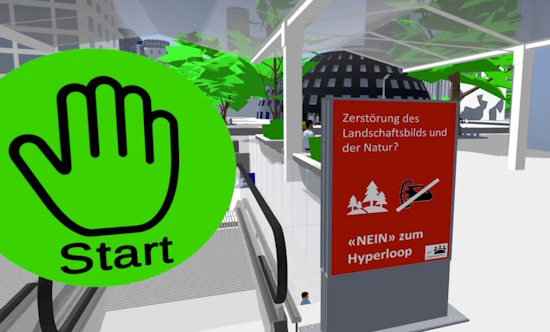[This Psychology Today summary of a new study by researchers in Switzerland touches on many of the things about presence and its promise and peril that I find interesting and important. Note the indirect references to several different types or dimensions of presence (e.g., as described in the ISPR definition), and the discussion of the potential of presence-evoking experiential media to both provide compelling entertainment and education but also to ethically or unethically persuade and manipulate, in this case in the increasingly fraught area of politics. –Matthew]

[Image: Source: University of Zurich, Department of Geography blog post “#110: I see and I remember. I do and I understand”]
Virtual Reality at the Ballot Box
Immersive experiences may influence votes more than facts do.
By Matilde Tassinari Ph.D.
Reviewed by Jessica Schrader
July 24, 2025
We tend to think of voting as the pinnacle of rational civic engagement: careful deliberation, critical assessment of arguments, and a sober march to the ballot box. But what if wearing a virtual reality headset could nudge your political decision-making enough to change your vote?
That’s a challenge to the very notion of political rationality, and it’s one that a team of researchers in Switzerland recently put to the test. Their experiment, using a fictitious popular vote, is somehow disquieting: Virtual reality (VR), simply by virtue of its immersive power, can sway how people vote, sometimes regardless of the arguments presented.
Voting Inside the Simulation
The researchers began with a seemingly simple premise: Could the format in which political information is presented—in this case, traditional text versus an immersive VR experience—affect how people vote? And if so, would it matter whether the arguments were in favor of or against the initiative?
To test this, they crafted a scenario around a fictional but realistic Swiss initiative to fund a national Hyperloop system, an ultra-high-speed travel system. Participants first read a brief description and cast an initial vote. Then, they were split into groups: Some read more detailed arguments in text form; others experienced a virtual journey inside a Hyperloop pod, complete with either positive or negative framing.
The result? Participants who saw the project through VR headsets were significantly more likely to change their minds in favor of the initiative, no matter whether the arguments they saw were against the initiative. The medium, it seems, had become the message.
The Power of the “Real” That Isn’t
Why did this happen? The researchers hypothesize that the key lies in the way humans process information. Reading a policy brief activates our slow, analytical thinking. But immersing ourselves in a vivid, interactive environment taps into something more powerful. VR short-circuits the cognitive distance between observer and event. When you sit in a virtual Hyperloop seat and see the world rush by, it’s not a piece of information, but rather an experience.
The study suggests six factors that help explain this phenomenon. First is the affirmative power of images: rather than simply showing, VR asserts. Visual scenes seem self-evident, even when they’re constructed. Then there’s vividness and realism: the more lifelike and sensory-rich the experience, the more it sticks in memory. Interactivity and experiencing a scenario from a first-person perspective add other layers, as it’s one thing to read about a new transport system, but another to feel like you’re riding inside it. The design of the environment, from soundscapes to ticket machines and digital screens, further reinforces the illusion of authenticity. Finally, most participants had never experienced VR before, suggesting that novelty itself may have heightened receptivity.
Interestingly, participants often didn’t even notice whether they were seeing pro- or anti-Hyperloop arguments. The immersive format itself appeared to eclipse content. “I changed my mind afterwards,” one participant said. “In VR, it just felt like I was on a fast train.”
The (Un)Conscious Vote
That comment hints at something deeper. In political science and psychology, we’ve long known that framing matters, but what if framing becomes so seamless, so embedded in the mode of presentation, that people aren’t aware of being influenced at all?
The VR experience in this study didn’t include narration or overt persuasion, using instead subtle cues, such as posters, announcements, and interface elements. The anti-Hyperloop version, for instance, had a broken ticket machine and a sick bag tucked into the seatback. Yet even these clues often went unnoticed. Most participants simply enjoyed the ride.
None of this means VR is inherently manipulative. In fact, it holds promise as a civic tool. Imagine being able to experience the environmental impact of a new highway, or walk through a refugee camp before voting on foreign aid. VR could democratize complex issues by making them tangible.
But the ethical stakes are real. As one participant noted, “With VR, you can present the information in a way that is attractive and, thus, influence the formation of opinion.” That’s the paradox: the same qualities that make VR a powerful medium for empathy and understanding also make it a potent instrument for persuasion. And persuasion, when unrecognized, edges uncomfortably close to manipulation.
For centuries, democracies have relied on reasoned argument presented in text, speech, and images. VR introduces a third domain: experiential media, which are capable of engaging emotion, intuition, and physical presence. It’s compelling, it’s credible, and it’s coming fast. So next time you put on a headset, ask yourself: Am I watching a story, or living one? And more importantly, who’s writing the script?
—
Reference:
Weber W, Dingerkus F, Fabrikant SI, Zampa M, West M and Yildirim O (2022) Virtual Reality as a Tool for Political Decision-Making? An Empirical Study on the Power of Immersive Images on Voting Behavior. Front. Commun. 7:842186. https://doi.org/10.3389/fcomm.2022.842186
Leave a Reply